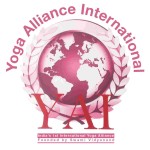Yoga and Multimedia Teacher Training Course Content
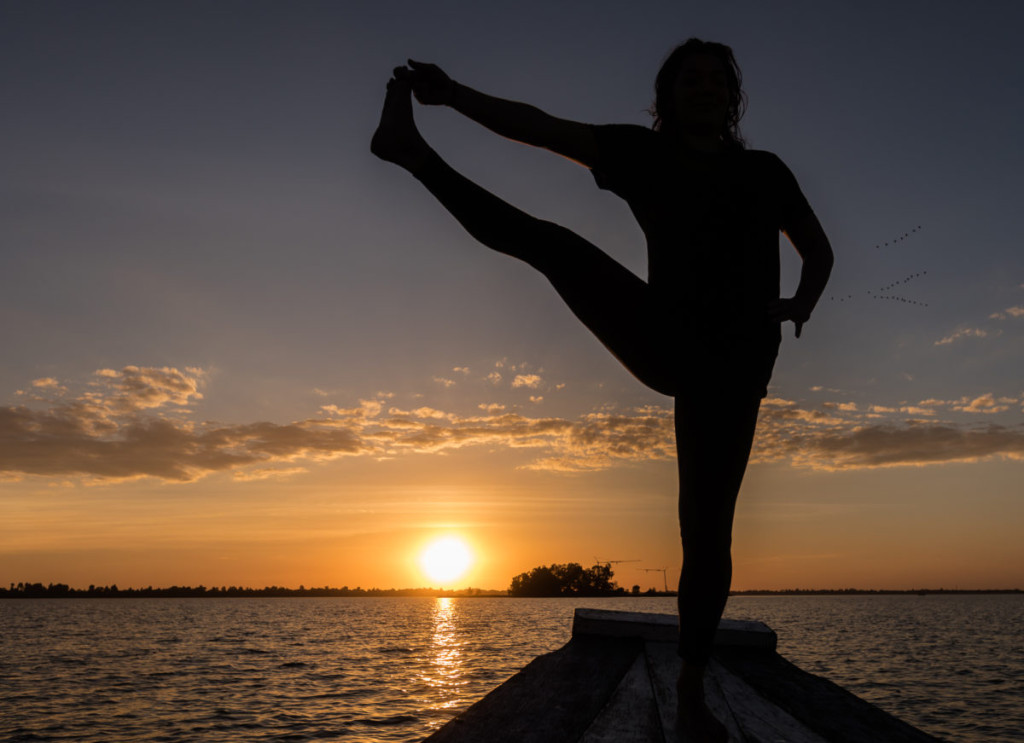
We designed this course with these principles in mind:
- be authentic – we encourage you to be yourself whether practicing or teaching the universal, timeless principles of Yoga
- be individual – this course is held in an intimate environment, and with 3 teachers, to ensure you receive the proper guidance and personal assistance
- be modern – we believe digital tools, when used ethically and creatively, are important for communication and self marketing – therefore we integrated a multimedia teaching course to this program
- enjoy – we will work hard and enjoy each moment, visit the Angkor temples, go to the acrobatic show, have great food, make new friends, build unforgettable memories…
DETAILED COURSE CONTENT
Techniques & Practices
-
Kriyas: Theory and practice, benefits and contraindications. Techniques and practical tips: Jala Neti, Langhoo Shankhaprakshalana, Kapalbhati, Trataka, Nauli/Agni Sar
-
Bandhas: Theory & practice: Moola Bandha, Uddiyana Bandha, Jalandhara Bandha, Maha Bandha
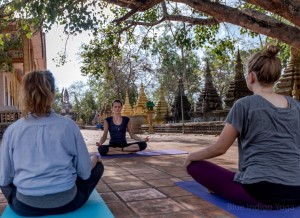
-
Pranayama: Theory & practical training: Prana & Pranic Body, % major and 5 minor Pranas, Pranayama: Sectional Breathing/Full Yogic Breathing, Alternate Nostril Breathing, Sheetali,Sheetkari, Sadanta Pranayama, Bhramari Pranayama, Ujjayi Pranayama, Bhastrika Pranayama, Kapalbhati
-
Mudras: Meaning and practice of selected mudras
-
Meditation Techniques: Silent Sitting (Vipasana) – introduction, Dynamic Meditations, Chakra Meditation, Mantra Meditation, OM Healing Meditation, Breath Meditation, Japa Mala
-
Mantras: Meaning and Chanting
Asana Practice including
-
Warm-up exercises & Sun Salutation in a few variations (Ashtanga/Vinyasa Flow, Hatha)
-
Asana practice (guided Hatha and Vinyasa daily classes):
-
Vinasa Flow: general sessions & thematic sessions: (e.g. “Happy Hips”, Heart opening”, Re-balancing Flow” etc.), tuning asanas with breathing
-
Hatha Yoga: rules of building a sequence, leading and assisting a class, significance of going “in” and “out” of the posture
-
-
Yin/Restorative Yoga practice – introduction
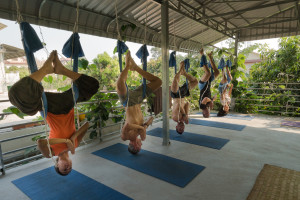
-
Aerial/Flying Yoga practice – introduction
-
Asana modifications for beginners and students with injuries (multi-level modifications)
-
Sequencing
-
Guided asana practice & analytical training focused on following groups of asanas:
-
Standing asanas, forward bends, back bands, twists, balances, inversions, hip openers
-
Finishing sequence & relaxing asanas
-
Alignment / adjustment
-
Asana in Yoga therapy – introduction
-
Teaching Methodology
-
Art of teaching: teacher’s qualities , intention & attitude, teaching styles, observation, giving instructions, feedback, sequencing, class management & class routine, principles of demonst
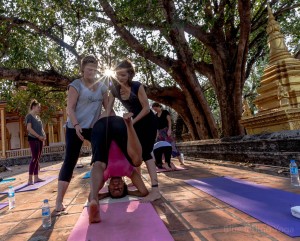 ration – theory and practice (“mirror” versus “real”)
ration – theory and practice (“mirror” versus “real”) -
Principles of adjustment & alignment, difference between adjustment and correction – theory and practice
-
Modes of adjustment (verbal, hands-on, props, partners), correction techniques
-
Safety in the asana practice – how to teach and practice Yoga without injuries
-
Practice in pairs
-
Starting a Yoga career & development – practical tips
-
Marketing strategies
-
Business & ethics
Anatomy & Physiology
-
General movement and body terminology
-
Systems of the human body – their meaning and functions
-
Breath deeply! – respiratory system in the context of yoga
-
The key muscles of Hatha Yoga – analyses of muscular work in asana practice
-
Body’s main limitations: compression – tension – proportion – orientation and their meaning in asana practice
-
Yoga and health – benefits and contraindications of asanas; basic elements of yoga therapy
Yogic Anatomy and Ayurveda
-
5 elements, 5 Koshas, 3 layers, Energy channels & Chakra theory
-
Ayurveda – introduction (Prakriti and Vikriti, 3 doshas, application of Ayurveda in teaching
and practicing Yoga, diet and lifestyle tips)
Yoga Philosophy
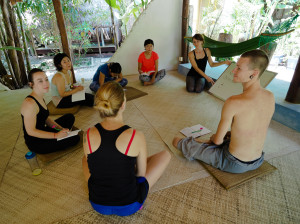
-
The meaning and history of Yoga
-
Schools of Yoga
-
Hatha Yoga Pradipika
-
Pantanjali Yoga Sutras/ Ashtanga Yoga
Multimedia teachings
“Be visible, look good, create and inspire“
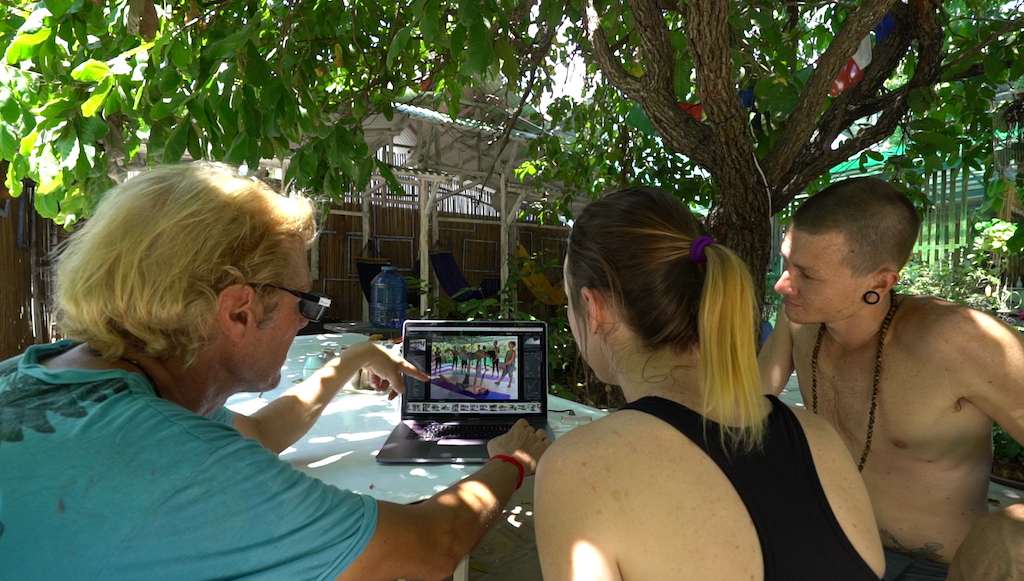
- Methodology – 20% theory, 80% practice, demystification of technology wirth focus on developing your artistic side, starting from basics and expanding based on appetites and abilities, with, as end results, a good understanding of photo and video making, a portfolio of images and videos, a presence on the internet with a website or blog with a good understanding of how to manage search engines, yoga sites, and social networks.
- Photo-shoots – we will be at the cottage, in temples, pagodas and forests, giving you an open field for creativity
- The equipment – bring your (camera, phone, computer), and you can also learn with our professional cameras. But you need a computer and a phone at least.
- Foundations:
- Overview – definitions, framework for this course (what we will learn and what we will not learn), basic terminology
- Ethics and values – copyrights, ownership, behaviors
- Your image – your identity, your goals
- Workflow – definition, approaches, strategy for speed and quality
- Strategy – visualizing the result, brainstorming, quantity and quality balance, telling the story, storyboarding
- The world’s ADD – keeping your audience engaged, short and long term
- Hardware – cameras, microphones, drones, accessories, computers
- Choosing the best tool based on conditions (time, abilities, budget, mobility)
- Cameras – understanding the price/capability ratio
- Software – photo and video editing tools
- Editing on phones, tablets, computers
- Photography & Video
- When to use static media (photo) and when to use motion media (video)
- Foundation – the light, the background, the subject
- Relationship between shutter-speed, aperture and ISO
- Background strategy – depth of field vs. sharpness
- Camera preparation – best settings for less headaches
- Composition
- Directing the subject, being directed
- Framing strategy – rule of third and other easy tools to create a visually appealing frame
- Photography – The art of telling a story or compelling the audience though a still image or 2
- Videography – Camera moves, the flow, the harmony, the pace of the clip
- Graphic design
- Create your logo, your identity
- Editing your media
- Post processing images to match your style and identity
- The role of the soundtrack (ambient sound, voice, music)
- Editing the clips to flow and keep the audience engaged and wanting more
- Sharing, inspiring
- WEB – Websites, social networks, blogs
- The internet – strategy for being found via search engines, advertisement, natural and paid search, Search engine optimisation (SEO)
- Picture sharing sites: Instagram, Snapchat, facebook and more
- Video sharing sites: Youtube, Vimeo, and your own website
- Yoga course and teacher sites: Bookyogaretreat and alike
Recommended reading
If you would like to prepare yourself for this course, here is a list of recommended books that will bring you a deeper insight into the Yogic practices.
Be awaret this is not compulsory in order to attend the course and that you don’t need to bring these books with you for the TTC.
Yoga Practices
- Asana, Pranayama, Mudra and Bandha: by Swami Satyananda Saraswati
- Prana and Pranayama by Swami S. Nirajanananda
- Yoga Nidra by Swami Satyananda Saraswati
- Sure Ways to Self Realization: by Swami Satyananda Saraswati
- The Yoga of Breath: A Step-by-Step Guide to Pranayama by Richard Rose
- The Heart of Yoga: Developing a Personal Practice, by T.K.V. Desikachar
- Journey Into Power by Baron Baptiste
Yoga Philosophy
- Hatha Yoga Pradipika by Muktibodhananda Swami
- Four Chapters on Freedom: Commentary on the Yoga Sutras of Patanjali: by Swami Satyananda Saraswati
- Yoga: The Greater Tradition by David Frawley
- How Yoga works by Michael Geshe Roach
Anatomy & Ayurveda
- Yoga Anatomy By Leslie Kaminof
- Yoga and Ayurveda by Dr. David Frawley
- Yoga & Ayurveda: Self-Healing and Self-Realization by Dr. David Frawley
- Ayurveda: Life, Health, and Longevity by Dr Robert Svoboda
- Prakriti: Your Ayuvredic Constitution by Dr. Robert Svoboda
- The Complete Book of Ayurvedic Home Remedies by Vasant Lad
Meditation
- Still the Mind: An Introduction to Meditation by Alan Watts
Other
- Autobiography of a Yogi by Paramhansa Yogananda
- Siddhartha by Hermann Hesse
Watch the following (DVD)
- Yoga anatomy by David Keil
- Yoga anatomy by Paul Grilley

